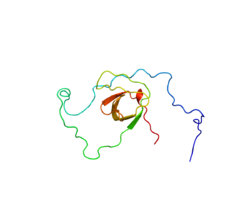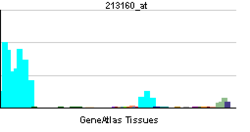- Dock2
-
Dock2 (Dedicator of cytokinesis 2), also known as DOCK2, is a large (~180 kDa) protein involved in intracellular signalling networks.[1] It is a member of the DOCK-A subfamily of the DOCK family of guanine nucleotide exchange factors (GEFs) which function as activators of small G proteins. Dock2 specifically activates isoforms of the small G protein Rac.
Contents
Discovery
Dock2 was first characterised as one of a number of proteins which shared high sequence similarity with the previously described protein Dock180, the archetypal member of the DOCK family. Whereas Dock180 expression is near ubiquitous in mammals, Dock2 appears to be expressed specifically in leukocytes and is considered to be the principal DOCK family member in these cells.[2]
Structure and Function
Dock2 is part of a large class of proteins (GEFs) which contibrute to cellular signalling events by activating small G proteins. In their resting state G proteins are bound to Guanosine diphosphate (GDP) and their activation requires the dissociation of GDP and binding of guanosine triphosphate (GTP). GEFs activate G proteins by promoting this nucleotide exchange.
Dock2 and other DOCK family proteins differ from other GEFs in that they do not possess the canonical structure of tandem DH-PH domains known to elicit nucleotide exchange. Instead they possess a DHR2 domain which mediates Rac activation by stabilising it in its nucleotide-free state.[3] They also contain a DHR1 domain which binds phospholipids and is required for the interaction between Dock2 and the plasma membrane.[4] As with other members of the DOCK-A and DOCK-B subfamilies, Dock2 contains an N-terminal SH3 domain which is involved in binding to ELMO proteins (see below).[5] Dock180 contains a C-terminal proline rich region which mediates binding to Crk, however, Dock2 lacks this feature[2] despite the fact that it is able to bind the Crk-like protein CrkL.[6]
Regulation of Dock2 activity
Efficient Dock180 GEF activity in a cellular context is known to require the formation of a complex between Dock180 and its cognate adaptor proteins, which assist its translocation to the plasma mambrane and binding to Rac.[7][8] Similarly, Dock2 has been shown to form a complex with the well described DOCK-binding protein ELMO1 and this interaction is required for Dock2-mediated Rac activation in lymphocyte cell lines.[5] ELMO proteins contain a C-terminal proline-rich region which binds to the N-terminal SH3 domain of DOCK proteins and mediates their recruitment to sites of high Rac availability (primarily the plasma membrane).[8] ELMO proteins also contain a PH domain which appears to induce conformational changes in DOCK and thus allow binding to Rac.[9]
Signalling downstream of Dock2
Like other DOCK-A and DOCK-B subfamily proteins Dock2 GEF activity is specific for Rac. Leukocytes express both Rac1 and Rac2 and Dock2 has been shown to bind and promote nucleotide exchange on both of these isoforms.[2] Rac isoforms regulate a multitude of processes in leukocytes and studies so far have shown that Dock2-dependent Rac activation regulates the neutrophil NADPH oxidase[4] and is also important for chemotaxis in neutrophils,[4][10] lymphocytes[11] and plasmacytoid dendritic cells.[12] Dock2-dependent NADPH oxidase activation was reported in response to the soluble agonist fMLP, which acts via G protein-coupled receptors in neutrophils.[4] Dock2-dependent chemotaxis has been reported in response to the chemokines CXCL12/SDF-1 in T lymphocytes, CXCL13/BLC in B lymphocytes and CCL19/ELC in thymocytes (immature lymphocytes) emigrating from the thymus[11] as well as CCL21/SLC in ex vivo plasmacytoid dendritic cells.[12] In neutrophil chemotaxis Dock2 signals downstream of the C5a and CXCL8/IL-8 receptors.[4][10] Additional receptors which signal through Dock2 include the T cell receptor/TCR[6] and EDG1, a sphingosine-1-phosphate (S1P) receptor.[13] Interestingly, the HIV-1 protein Nef is able to constitutively activate Dock2 in T lymphocytes which disrups chemotaxis and immunological synapse formation thereby inhibiting the antiviral immune response.[14]
Interactions
Dock2 has been shown to interact with CRKL.[15]
References
- ^ "Entrez Gene: DOCK2 dedicator of cytokinesis 2". http://www.ncbi.nlm.nih.gov/sites/entrez?Db=gene&Cmd=ShowDetailView&TermToSearch=1794.
- ^ a b c Nishihara H, Kobayashi S, Hashimoto Y, et al. (November 1999). "Non-adherent cell-specific expression of DOCK2, a member of the human CDM-family proteins". Biochim. Biophys. Acta. 1452 (2): 179–87. doi:10.1016/S0167-4889(99)00133-0. PMID 10559471.
- ^ Côté JF, Vuori K (December 2002). "Identification of an evolutionarily conserved superfamily of DOCK180-related proteins with guanine nucleotide exchange activity". J. Cell Sci. 115 (Pt 24): 4901–13. doi:10.1242/jcs.00219. PMID 12432077.
- ^ a b c d e Kunisaki Y, Nishikimi A, Tanaka Y, et al. (August 2006). "DOCK2 is a Rac activator that regulates motility and polarity during neutrophil chemotaxis". J. Cell Biol. 174 (5): 647–52. doi:10.1083/jcb.200602142. PMC 2064308. PMID 16943182. http://www.pubmedcentral.nih.gov/articlerender.fcgi?tool=pmcentrez&artid=2064308.
- ^ a b Sanui T, Inayoshi A, Noda M, et al. (October 2003). "DOCK2 regulates Rac activation and cytoskeletal reorganization through interaction with ELMO1". Blood 102 (8): 2948–50. doi:10.1182/blood-2003-01-0173. PMID 12829596.
- ^ a b Nishihara H, Maeda M, Oda A, et al. (December 2002). "DOCK2 associates with CrkL and regulates Rac1 in human leukemia cell lines". Blood 100 (12): 3968–74. doi:10.1182/blood-2001-11-0032. PMID 12393632.
- ^ Hasegawa H, Kiyokawa E, Tanaka S, et al. (April 1996). "DOCK180, a major CRK-binding protein, alters cell morphology upon translocation to the cell membrane". Mol. Cell. Biol. 16 (4): 1770–76. PMC 231163. PMID 8657152. http://www.pubmedcentral.nih.gov/articlerender.fcgi?tool=pmcentrez&artid=231163.
- ^ a b Katoh H, Negishi M (July 2003). "RhoG activates Rac1 by direct interaction with the Dock180-binding protein Elmo". Nature 424 (6947): 461–64. doi:10.1038/nature01817. PMID 12879077.
- ^ Lu M, Kinchen JM, Rossman KL, et al. (2004). "PH domain of ELMO functions in trans to regulate Rac activation via Dock180". Nat. Struc. Mol. Biol. 11 (8): 756–62. doi:10.1038/nsmb800. PMID 15247908.
- ^ a b Sai J, Raman D, Liu Y, et al. (July 2008). "Parallel PI3K-dependent and Src-dependent pathways lead to CXCL8- mediated Rac2 activation and chemotaxis". J. Biol. Chem. Article in press (39): 26538–47. doi:10.1074/jbc.M805611200. PMC 2546539. PMID 18662984. http://www.pubmedcentral.nih.gov/articlerender.fcgi?tool=pmcentrez&artid=2546539.
- ^ a b Fukui Y, Hashimoto O, Sanui T, et al. (August 2001). "Haematopoietic cell-specific CDM family protein DOCK2 is essential for lymphocyte migration". Nature 412 (6849): 826–31. doi:10.1038/35090591. PMID 11518968.
- ^ a b Gotoh K, Tanaka Y, Nishikimi A, et al. (March 2008). "Differential requirement for DOCK2 in migration of plasmacytoid dendritic cells versus myeloid dendritic cells". Blood 111 (6): 2973–76. doi:10.1182/blood-2007-09-112169. PMID 18198348.
- ^ Nombela-Arrieta C, Mempel TR, Soriano SF, et al. (March 2007). "A central role for DOCK2 during interstitial lymphocyte motility and sphingosine-1-phosphate-mediated egress". J. Exp. Med. 204 (3): 497–510. doi:10.1084/jem.20061780. PMC 2137902. PMID 17325199. http://www.pubmedcentral.nih.gov/articlerender.fcgi?tool=pmcentrez&artid=2137902.
- ^ Janardhan A, Swigut T, Hill B, et al. (January 2004). "HIV-1 Nef binds the DOCK2-ELMO1 complex to activate rac and inhibit lymphocyte chemotaxis". PLoS Biol. 2 (1): e6. doi:10.1371/journal.pbio.0020006. PMC 314466. PMID 14737186. http://www.pubmedcentral.nih.gov/articlerender.fcgi?tool=pmcentrez&artid=314466.
- ^ Nishihara, Hiroshi; Maeda Masae, Oda Atsushi, Tsuda Masumi, Sawa Hirofumi, Nagashima Kazuo, Tanaka Shinya (Dec. 2002). "DOCK2 associates with CrkL and regulates Rac1 in human leukemia cell lines". Blood (United States) 100 (12): 3968–74. doi:10.1182/blood-2001-11-0032. ISSN 0006-4971. PMID 12393632.
Further reading
- Reif K, Cyster J (2003). "The CDM protein DOCK2 in lymphocyte migration.". Trends Cell Biol. 12 (8): 368–73. doi:10.1016/S0962-8924(02)02330-9. PMID 12191913.
- Brugnera E, Haney L, Grimsley C, et al. (2002). "Unconventional Rac-GEF activity is mediated through the Dock180-ELMO complex.". Nat. Cell Biol. 4 (8): 574–82. doi:10.1038/ncb824. PMID 12134158.
- Lu M, Kinchen JM, Rossman KL, et al. (2005). "A Steric-inhibition model for regulation of nucleotide exchange via the Dock180 family of GEFs.". Curr. Biol. 15 (4): 371–7. doi:10.1016/j.cub.2005.01.050. PMID 15723800.
- García-Bernal D, Sotillo-Mallo E, Nombela-Arrieta C, et al. (2007). "DOCK2 is required for chemokine-promoted human T lymphocyte adhesion under shear stress mediated by the integrin alpha4beta1.". J. Immunol. 177 (8): 5215–25. PMID 17015707.
- Meller N, Merlot S, Guda C (November 2005). "CZH proteins: a new family of Rho-GEFs". J. Cell Sci. 118 (Pt 21): 4937–46. doi:10.1242/jcs.02671. PMID 16254241.
- Côté JF, Vuori K (2007). "GEF what? Dock180 and related proteins help Rac to polarize cells in new ways". Trends Cell Biol. 17 (8): 383–93. doi:10.1016/j.tcb.2007.05.001. PMC 2887429. PMID 17765544. http://www.pubmedcentral.nih.gov/articlerender.fcgi?tool=pmcentrez&artid=2887429.
- Lu M, Ravichandran KS (2006). "Dock180-ELMO cooperation in Rac activation". Meth. Enzym. 406: 388–402. doi:10.1016/S0076-6879(06)06028-9. PMID 16472672.
Categories:- Human proteins
Wikimedia Foundation. 2010.


